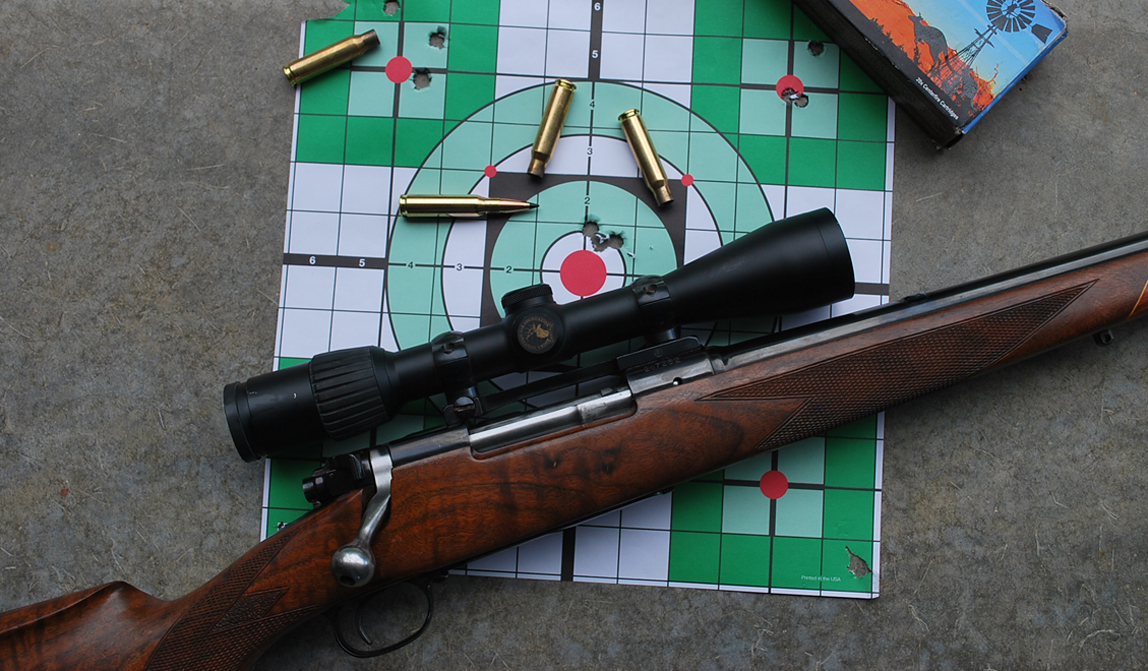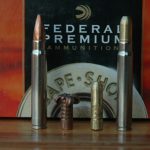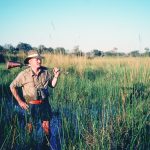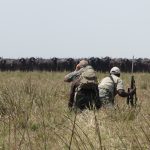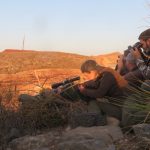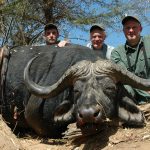But how much gun is enough?
There is a difference between what you can (sometimes) get away with, and what you should do. The title phrase predates Robert Ruark, but Use Enough Gun is the title of his excellent posthumous collection, published shortly after the author’s death in 1965. Ruark was referring mostly to dangerous game, which in his short but peripatetic safari career he had rich opportunity to pursue: Lots of buffalo, several big elephants, a score of leopards. Ruark was badly mauled by an Asian leopard. He blamed faulty Indian ammunition, but in those days of unrestricted travel I’ve always wondered why he was using questionable ammo? Ruark took two lions on his first safari, and apparently had no desire to hunt them again, but he shot multiple tigers. He also took his famous Westley Richards .470 on an Alaskan brown bear hunt, so he practiced what he preached.
With dangerous game, common sense tends to rule. Generations of experience—and some local laws—suggest sensible parameters for dangerous game rifles and cartridges. In Botswana thirty years ago, a local hunter came in behind us on a buffalo herd, wounded one, and got himself badly unzipped. He was using a .30-06, which tradition suggests is unwise, and Botswana law said was illegal.
Unfortunately, it isn’t always the brash hunter who bears the consequences. Veteran B.C. guide Cy Ford was guiding a hunter who wounded a huge grizzly with a 7mm Remington Magnum, despite warnings the cartridge was too light. The shot was fairly good, but not good enough. Ford went into thick stuff after the bear. The search party later found the bear, dead in a small clearing “like a black Volkswagen beetle.” Several hours passed before they found Ford’s mangled body. His .30-06 was unfired, and it appeared he never had a chance.
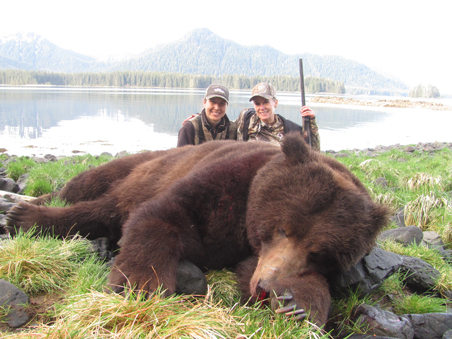 Guide Alisha Rosenbruch-Decker and Donna Boddington with a big Alaskan brown bear taken cleanly with a .338 Winchester Magnum. Decker’s experienced outfit prefers a .375 minimum for brown bear, a thought worth considering.
Guide Alisha Rosenbruch-Decker and Donna Boddington with a big Alaskan brown bear taken cleanly with a .338 Winchester Magnum. Decker’s experienced outfit prefers a .375 minimum for brown bear, a thought worth considering.
Big bears can be tough. In 2013 Donna took a giant brown bear with a .338. I think that was a good choice, but we either missed (or possibly ignored) the outfitter’s stipulation of “.375 minimum for brown bear.” Fortunately, she pasted her bear perfectly; her follow-up shot was unnecessary. Only later did guide and famous bear hunter Alisha Rosenbruch-Decker tell us that this was the only brown bear she’d seen taken cleanly with a .338. The .338 should be enough gun, but this is food for thought.
Most of us accept that big, dangerous animals require more power, and most of us comply. Some would say that I often “over-comply.” I am a child of the first magnum phase, the 1950s and 1960s. Good Lord, I shot my first elk (and my first sheep, caribou, and moose) with a .375! That was unnecessary power, but it worked. I’ve mellowed, but I find being “overgunned” a more elusive concept than being “undergunned.” The downsides to the former are you’re carrying more gun weight and sustaining more recoil. You are not necessarily ruining more meat, because large-caliber bullets tend to punch through. However, without question, you are not carrying the ideal tool. To me, the downside to not using enough gun is worse. On non-dangerous animals nobody is going to get hurt. But, as ethical hunters, isn’t it our credo to take game as cleanly as possible? Lack of “enough gun” leads to wounded animals and wasted game, and this is not acceptable.
A century ago, when smokeless powder velocities and jacketed bullets were new, we had almost simultaneous smallbore fads in both Africa and North America. They were different because African hunters were euphoric over the awesome penetration from long-for-caliber “solids” in early smokeless military cartridges from 6.5mm to 8mm. In the early 1900s these cartridges were widely used for game up to elephant. They worked, but times were different; if you read old accounts carefully you’ll discover a wounded-and-lost rate that would be unacceptable today. By the 1930s the argument in Africa was pretty much over; cooler heads had prevailed and things were much as they are today: The 9.3mms and .375s are considered minimal, and many hunters use larger calibers.
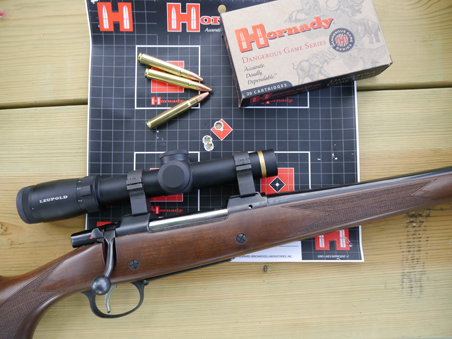 An accurate CZ chambered to the old 9.3×62 Mauser. Today this cartridge is generally considered a bare-bones minimum for African dangerous game. Mild in recoil with heavy-for-caliber 286-grain bullets it’s a sensible minimum based on decades of experience.
An accurate CZ chambered to the old 9.3×62 Mauser. Today this cartridge is generally considered a bare-bones minimum for African dangerous game. Mild in recoil with heavy-for-caliber 286-grain bullets it’s a sensible minimum based on decades of experience.
In North America we ran out of mammoths in the last Ice Age and, by the time of smokeless powder, the bison were nearly gone. Our “adequacy issues” started in 1912 with the .22 Savage Hi-Power and continued in 1915 with the .250 Savage, the first commercial cartridge to reach 3,000 feet per second. The Savage Hi-Power used a 70-grain .228-inch bullet at 2,700 feet per second. Unlike .22 centerfires that followed, it was intended for deer-sized game. The .250 Savage used a light 87-grain bullet to achieve its velocity. Both were ground-breaking cartridges, and both suffered from lack of bullet technology to withstand the velocity. The .22 Hi-Power was briefly the darling of the sporting press, and then came the .250-3000.
Both were used on all manner of game much too large for their caliber, power, and bullet performance. When all went well they dropped game like lightning, but things didn’t always go well. Word got out. Centerfire .22s came to be considered varmint cartridges. The .250 Savage is a fine deer/pronghorn cartridge, but it achieved its lasting reputation with 100-grain bullets at lower velocity.
It seems we have to keep learning the same lessons. Today’s great bullets make a huge difference; with heavy bullets (and in careful hands) the .22 centerfires are effective deer cartridges, but nobody advocates their use for elk or black bears, and no one should. In North America we don’t have the Big Five. Our “special case” animals are our big bears, plus a few bison, muskoxen, and walruses. We have deer-sized game: Deer, sheep, goats, and pronghorns; caribou aren’t enough larger than deer to up the ante. Black bears are potentially bigger and always tougher. So are wild hogs. However, we also have elk and moose, much larger than all the rest! Moose, though bigger, are not especially tough; elk are very tough, and a mature bull elk is a whole different order of magnitude from a tasty cow or spike.
The current popularity of the 6.5mm Creedmoor is an interesting phenomenon. It’s a great little cartridge, ballistically identical to the .260 Remington, also a great little cartridge, though not as popular. Both are awesome for deer-sized game at medium ranges. Likewise, the 7mm-08, and old-timers like the 6.5×55 and 7.×57. Their standard 140-grain bullets, all at similar velocities, are capable of taking elk-sized game cleanly at moderate range. Mild recoil aids good shot placement, but I am concerned about the seemingly magical properties currently ascribed to the 6.5mm Creedmoor. It uses a 140-grain .264-inch bullet at 2,700 feet per second. This is not a giant slayer. Although a wonderful long-range target cartridge, it is not an ideal long-range cartridge even on deer-sized game; and it is marginal for elk. This group of cartridges do not equal the fast 6.5mms, and they do not equal the .270s. These, to my thinking, offer sensible minimums for elk, but not at longer ranges. If you want a low-recoil option for elk, think about the .308 Winchester, but keep to medium distances. It will take time for the word to get out, but, as autumn seasons get underway, it is a fact that, right now, elk are being unnecessarily wounded with mild 6.5s and 7mms. I predict the euphoria will pass, as it has before.
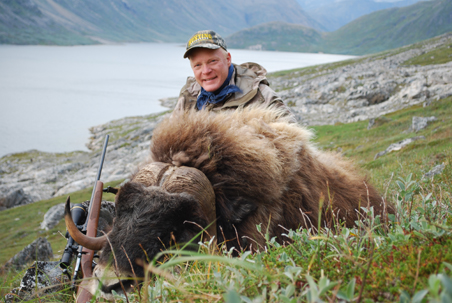 This Greenland muskox was taken with a single 130-grain Barnes X from a .270. Reasonably and sensibly, the outfitter prefers a .30-caliber minimum for muskox. When one goes against conventional wisdom there’s always unnecessary risk.
This Greenland muskox was taken with a single 130-grain Barnes X from a .270. Reasonably and sensibly, the outfitter prefers a .30-caliber minimum for muskox. When one goes against conventional wisdom there’s always unnecessary risk.
Over the course of extensive hunting experience most of us, for various reasons, will push the envelope now and again. Knowing one is inadequately armed leads to extra care, so most of the time we get away with it. One year in northern Mexico my gun case didn’t arrive, so I went mule deer hunting with the ranch rifle, an old CZ in .222 Remington. One shot and down; I got away with it, but I knew it was risky. In Greenland outfitter Bjorn Birgisson stipulated a reasonable .30-caliber minimum for muskox. For some reason I pitched up with a .270. With a tough bullet it worked fine; it’s a good thing, or the “I told you so” would have been unpleasant. It is impossible to gauge exactly how much bullet weight, frontal area, and kinetic energy is required because every shot and every animal is slightly different. Still, we have generations of experience to rely upon. Little has changed since the shift to smokeless powder, and we have an ever-increasing mandate to take our game cleanly, efficiently, and humanely. And we have lots of choices. There is no compelling reason to defy those decades of experience to see what we can get away with.

